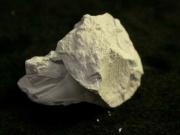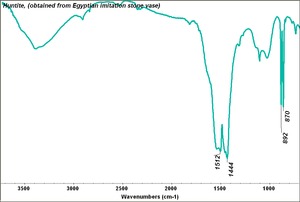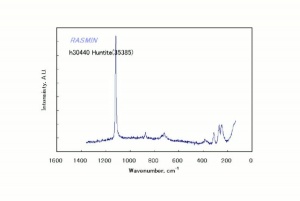Difference between revisions of "Huntite"
Jump to navigation
Jump to search
m (Text replace - "== Authority ==" to "== Sources Checked for Data in Record ==") |
|||
| Line 4: | Line 4: | ||
A soft, white mineral composed of magnesium calcium carbonate. The mineral huntite was first described by Faust in 1953 and its use as a pigment by ancient Egyptians was identified by Riederer in 1974 (Eastaugh et al 2004). | A soft, white mineral composed of magnesium calcium carbonate. The mineral huntite was first described by Faust in 1953 and its use as a pigment by ancient Egyptians was identified by Riederer in 1974 (Eastaugh et al 2004). | ||
| − | [[[SliderGallery rightalign| | + | [[[SliderGallery rightalign|Huntite PMA.TIF~FTIR (MFA)|huntiteRS.jpg~Raman]]] |
== Other Properties == | == Other Properties == | ||
Revision as of 08:08, 4 December 2019
Description
A soft, white mineral composed of magnesium calcium carbonate. The mineral huntite was first described by Faust in 1953 and its use as a pigment by ancient Egyptians was identified by Riederer in 1974 (Eastaugh et al 2004).
Other Properties
Microscopically similar to calcite. Moderate birefringence with strong interference colors.
| Composition | Mg3Ca(CO3)4 |
|---|---|
| Refractive Index | ~1.625 |
Additional Information
° Nicholas Eastaugh, Valentine Walsh, Tracey Chaplin, Ruth Siddall, Pigment Compendium, Elsevier Butterworth-Heinemann, Oxford, 2004
° B. Ford, I.MacLeod, P.Haydock, "Rock art pigments from Kimberley region of Western Australia: identification of the minerals and conversion mechanisms." Studies in conservation 39, no. 1 (1994), pp. 57-69
Sources Checked for Data in Record
- Nicholas Eastaugh, Valentine Walsh, Tracey Chaplin, Ruth Siddall, Pigment Compendium, Elsevier Butterworth-Heinemann, Oxford, 2004 Comment: Refractive index: w=1.679; e=1.500


